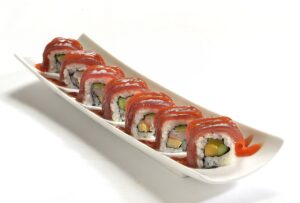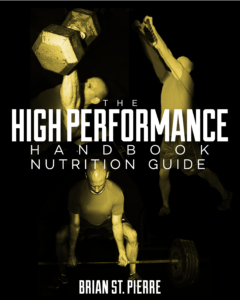
8 Nutritional Strategies For Those Who Can’t Gain Weight
In the early days of Cressey Sports Performance – when my wife and I didn’t have children of our own – during the off-season, we had professional baseball players staying with us quite a bit. It’s very common for athletes to come to town for a few days, do a little “crash course” at CSP on training and nutrition, and then head back home, where I’ll program for them from afar.
In almost all these cases, one of the biggest eye-opening experiences for these athletes was eating with the Cresseys. They learn new recipes and cooking practices, and many are a bit amazed at how much I eat in spite of the fact that I’m only about 185 pounds. They come to CSP expecting to learn about arm care, pitching mechanics, and strength and conditioning, but the nutrition add-on is a nice bonus.
As an example, several years ago, one athlete put on over ten pounds in the month of January while staying with us before he headed to Big League Spring Training. Sure, some of this is old weight that he had to “recoup,” and some is likely just water weight. However, being heavy enough going into spring training is profoundly important, particularly for position players who are out in the field almost every day between February and October. Below are some nutritional strategies we’ve employed with not only him, but a lot of our other skinny guys.
1. Get around big eaters, and make eating a social challenge.
With the skinny guys who complain about how they “eat all the time and still can’t gain weight,” it’s not uncommon for them to get a big slice of humble pie when dining around bigger eaters. In the Cressey household this month, Anthony had to keep up with me at every dinner – so if I got seconds, so did he.
I’ve also had athletes who always made a point of going out to eat with each other after training sessions. It’s instant accountability with respect to caloric intake. Sushi is a great option in this regard.
2. Cook with more oil.
When an athlete’s day is spent “uncomfortably full,” finding convenient ways to add calories is incredibly important – especially if that individual has multiple training sessions per day and can’t be worried about getting sick in the gym or on the field. Adding in some healthy oils – olive and coconut are my two “go-to” choices – can make it easier to get an extra 200+ calories at each meal. The healthy fats the athletes get are nice perks of this approach, too.
3. Eat faster.
We always tell people who want to lose weight to eat slower, but many people fail to appreciate that eating faster is actually a great option for true “hard-gainers.” You see, it takes time for the body to perceive fullness, so if you can get your calories in a bit faster, you can essentially trick yourself out of fullness.
As an interesting aside to this, my business partner, Pete, is one of the slowest eaters on the planet. No joke: it’ll take him four hours to finish a protein bar. And, not surprisingly, any time that Pete has put weight on in the past, he’s had to be “uncomfortable full” for months on end.
Brian St. Pierre discussed this “speed of eating” phenomenon in The High Performance Handbook Nutrition Guide, if you’re interested in learning more.
4. Have convenient calories wherever you can’t miss them.
One other strategy Anthony uses are homemade protein bars. They’re made with healthier ingredients, and without preservatives. This means they have to be refrigerated, but it also means that they’re going to go bad if he doesn’t get in 2-3 per day, so there is incentive to consume them faster. It’s an easy 1,000 calories on top of his normal meals, and also provides some convenience when he’s away from the kitchen. Most importantly, though, he has to see them every time he opens the refrigerator for anything, so they’re ultra-convenient.
5. Use liquid nutrition.
With most of our clients, we heavily emphasize eating real food and not getting calories from drinks. In those who struggle to gain weight, however, big shakes can really help. Tim Collins was a good example, as he’d have a 1,000+ calorie shake after each training session for his first few years of training until he arrived at a good weight…45 pounds heavier.
With that said, stay away from those garbage high-calorie weight gainers. They’re usually loaded with sugar and unhealthy fats – not to mention low-quality protein. I would always much rather have guys make their own shakes with a decent low-carb protein powder (I’m a huge fan of 1stPhorm Phormula-1), and then add almond or whole milk, coconut oil, fruits, natural nut butters, Greek yogurt, oats, ground flax, and even veggies. If you’re going to take in 1,000 calories in a shake, you might as well get some nutritional value from it. Be sure to add in creatine monohydrate; it’s the most researched supplement in history and is a great inclusion for anyone looking to add muscle mass and improve performance.
6. Write it down.
One of the best ways to evaluate how much you’re eating – whether you’re trying to lose fat or gain muscle – is to simply write it down. I’d estimate that in 95% of cases, having a “hard-gainer” do thise immediately eliminates the “but I eat all the time” argument. Sometimes, just knowing that you aren’t trying as hard as you think you are is the biggest key to subsequent progress.
7. Review medications.
Many medications can have a profound impact on appetite. The most prominent effects I’ve seen are with ADD/ADHD medications, as most reduce appetite. In one instance, we had an athlete struggle to gain weight for almost two years on Adderall, but then he put on over 40 pounds in a year after switching to Focalin for his ADHD. It’s completely outside of my scope of practice to make recommendations on this front, but if appetite suppression is a concern, it’d be good to talk with your doctor about other options that might be available.
8. Make time instead of finding time.
Having an insanely busy schedule usually leads people to eat unhealthy, convenient foods – and they get fatter. Many folks who are underweight actually go in the opposite direction; they simply forget to eat when things get busy. To that end, if you want to gain weight, you need to make eating a priority – and that starts with plugging a specific time you’ll eat into your schedule.
While I’ve got your ear, if you’re looking for a one-time consultation at Cressey Sports Performance, just drop us an email at cspflorida@gmail.com (Palm Beach Gardens, FL location) or cspmass@gmail.com (Hudson, MA location).





